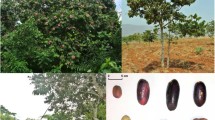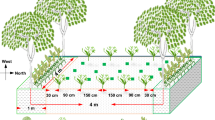Abstract
Hilly topography and inaccessible markets leave limited alternatives for Lao upland farmers who grow rice in slash-and-burn systems. They plant banana, mango, papaya, coconut and other perennials and collect forest products, specially bamboo shoot, banana inflorescence, rattan, cardamom, and benzoin for home consumption and market. Teak is the most important perennial planted on upland fields but farmers having teak are more likely to belong to the lowland ethnic groups and own lowland rice fields. Farmers preferred teak over fruit trees and coffee because of the better market potential and 82% considered cash income or wood for construction and 18% the securing of land tenure as major reasons for planting teak. Insufficient financial resources, non-availability of land, lack of seedlings, lack of labor and lack of experience were regarded as the main reasons for not planting teak by 41, 39, 35, 28 and 13% of non-teak growers, respectively. Plantations are often interplanted with rice for the first 1–3 years. Resource-poor families generally cannot risk the long-term investments and credit or modified systems combining food, livestock, and timber production are necessary to allow them to take part in the potentially lucrative teak production.
Similar content being viewed by others
References
Felker P and Bandurski RS (1979) Uses and potential use of leguminous trees for minimal energy input agriculture. Econ Bot 33: 172–184
Halpern JAM (1961) Economy and Society of Laos. Monograph Series No 5. Yale University, New Haven, CT
Hakangard A, Cooper J, Kennavaong M, Knotnhotha B, Sayadarath A and Fang C (1990) Women in Shifting Cultivation, Luang Prabang Province LAO PDR. SIDA/LAO PDR
Hoare P and Patanapongsa N (1988) Long-rotation, high value trees: an alternative strategy for private forestry. Commonw For Rev 67(4): 351–361
Izikowitz KG (1951) Lamet Hill peasants in French Indochina. Etnologiska studier 17. Etnografiska Museet. Goteborg
Kunstadter P and Chapman EC (1978) Problems of shifting cultivation and economic development in Northern Thailand. In: Kunstadter P, Chapman EC and Sabhasri S (eds) Farmers in the Forest, pp 3–23. East-West Center, University Press Hawaii, Honolulu
Mackie C (1985) Shifting cultivators and deforestation: the case of Borneo's forest fires. Culture and Agriculture 25: 1–4
Malpuech (1924) Le Laos economique, Hanoi (cited in: W Credner, 1935, Siam das Land der Tai, J. Engelhorns Nachf. Stuttgart)
Mouhot H (1864) Travels in the Central Parts of Indo-china (Siam), Cambodia, and Laos. J. Murray London (Reprinted in 1986 by White Lotus, Bangkok)
Posey DA (1985) Indigenous management of tropical forest ecosystems: the case of the Kayapo Indians of the Brazilian Amazon. Agroforestry Systems 3: 139–158
Robison DM and McKean SJ (1992) Shifting Cultivation and Alternatives: An Annotated Bibliography 1972–1989. CAB International, Wallingford, UK
Roder W, Leacock W, Vienvonsith N and Phantanousy B (1991) Relationship between ethnic group and land use in Northern Laos. Poster presented at the International Workshop on Evaluation for Sustainable Land Management in the Developing World. Chiang Rai, Thailand 15–21 September 1991. IBSRAM, Bangkok
Roder W, Manivong V, Leacock W and Soukhaponh H (1992) Farming systems research in the uplands of Laos. Proceedings Upland Rice-Based Farming Systems Research Planning Meeting, pp 39–54. Chiang Mai, DOA Thailand, Bangkok and IRRI, Philippines
Roder W, Phouaravanh B, Phengchanh S, Keoboualapha B and Maniphone S (1994) Upland agriculture-activities by LAO-IRRI Project. In: Shifting Cultivation and Rural Development in the LAO PDR, Report of the Nabong Technical Meeting, pp. 152–169. Nabong College, Vientiane
Singh GB and Singh W (1980) Shifting cultivation in the N.E. region. Indian Farming 29: 17–20
Stuart-Fox M (1986) Laos-Politics, Economics and Society. Frances Pinter, London
Tayanin D (1992) Environment and nature change in Northern Laos. In: Bruuno and Kalland A (eds) Asian Perceptions of Nature. Nordic Proceedings in Asian Studies No 3, NIAS, pp 131–147. Copenhagen
Warner K (1991) Shifting cultivators-local technical knowledge and natural resource management in the humid tropics. Community Forestry Note 8, FAO, Rome
Author information
Authors and Affiliations
Rights and permissions
About this article
Cite this article
Roder, W., Keoboualapha, B. & Manivanh, V. Teak (Tectona grandis), fruit trees and other perennials used by hill farmers of northern Laos. Agroforest Syst 29, 47–60 (1995). https://doi.org/10.1007/BF00711281
Issue Date:
DOI: https://doi.org/10.1007/BF00711281




